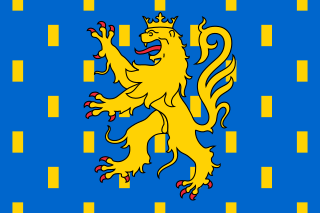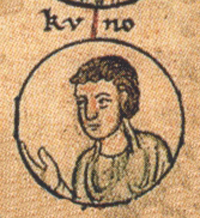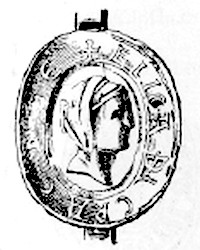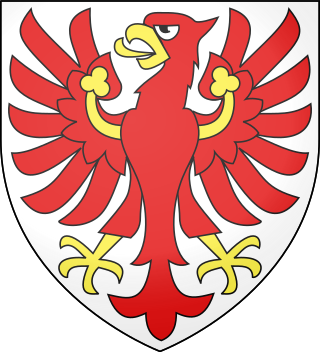Related Research Articles

The House of Wittelsbach is a former German dynasty, with branches that have ruled over territories including Bavaria, the Palatinate, Holland and Zeeland, Sweden, Denmark, Norway, Hungary, Bohemia, the Electorate of Cologne and other prince-bishoprics, and Greece. Their ancestral lands of the Palatinate and Bavaria were Prince-electorates, and the family had three of its members elected emperors and kings of the Holy Roman Empire. They ruled over the Kingdom of Bavaria which was created in 1805 and continued to exist until 1918.

Henry the Proud, a member of the House of Welf, was Duke of Bavaria from 1126 to 1138 and Duke of Saxony as well as Margrave of Tuscany and Duke of Spoleto from 1137 until his death. In 1138 he was a candidate for the election as King of the Romans but was defeated by Conrad of Hohenstaufen.

Conrad, a member of the Hohenstaufen dynasty, was the only son of Emperor Frederick II from his second marriage with Queen Isabella II of Jerusalem. He inherited the title of King of Jerusalem upon the death of his mother in childbed. Appointed Duke of Swabia in 1235, his father had him elected King of Germany and crowned King of Italy in 1237. After the emperor was deposed and died in 1250, he ruled as King of Sicily until his death.

The Free County of Burgundy or Franche-Comté was a medieval county of the Holy Roman Empire, predecessor to the modern region of Franche-Comté. The name franc(he) comté derives from the title of its count, franc comte, in German Freigraf 'free count', denoting imperial immediacy. It should not be confused with the more westerly Duchy of Burgundy, a fiefdom of France since 843.
Conrad II, was Duke of Rothenburg (1188–1191) and Swabia from 1191 until his death. He was the fifth son of Frederick I Barbarossa and Beatrice I, Countess of Burgundy.

Gertrude of Merania was Queen of Hungary as the first wife of Andrew II from 1205 until her assassination. She was regent during her husband's absence.

Louis I, called the Kelheimer or of Kelheim, since he was born and died at Kelheim, was the Duke of Bavaria from 1183 and Count Palatine of the Rhine from 1214. He was a son of Otto I and his wife Agnes of Loon. Louis was married to Ludmilla, a daughter of Duke Frederick of Bohemia.

Otto I, called the Redhead, was Duke of Bavaria from 1180 until his death. He was also called Otto VI as Count Palatine of Bavaria from 1156 to 1180. He was the first Bavarian ruler from the House of Wittelsbach, a dynasty which reigned until the abdication of King Ludwig III of Bavaria in the German Revolution of 1918.

Conrad I, a member of the Salian dynasty, was Duke of Carinthia from 1004 until his death.
Henry I was the count of Limburg and Arlon from 1082 to his death and duke of Lower Lorraine between 1101 and 1106. His mother was Jutta, daughter of Frederick, Duke of Lower Lorraine, and his father is uncertain, but possibly named Count Udon.
Otto III, a member of the House of Andechs, was Count of Burgundy from 1231 and the last duke of Merania from 1234 until his death.

Otto I, a member of the House of Andechs, was Duke of Merania from 1204 until his death. He was also Count of Burgundy from 1208 to 1231, by his marriage to Countess Beatrice II, and Margrave of Istria and Carniola from 1228 until his death.
Ulric II was the Margrave of Istria from 1098 until circa 1107 and Carniola from 1098 until his death. He was the second son of Ulric I and Sophia, a daughter of Bela I of Hungary. He was thus of royal blood.
The House of Sponheim or Spanheim was a medieval German noble family, which originated in Rhenish Franconia. They were immediate Counts of Sponheim until 1437 and Dukes of Carinthia from 1122 until 1269. Its cadet branches ruled in the Imperial County of Ortenburg-Neuortenburg and various Sayn-Wittgenstein states until 1806.
Conrad I was the Duke of Merania from 1152 until his death. Thitherto he had been the advocate of St Andreas at Freising since 1150 and Count of Dachau from 1152.

Matilda of Brandenburg, a member of the House of Ascania, was first Duchess consort of Brunswick-Lüneburg from 1235 to 1252 by her marriage with the Welf duke Otto the Child.

Heilika of Pettendorf-Lengenfeld was by marriage Countess Palatine of Bavaria.

Dedi III, nicknamed the Fat, a member of the House of Wettin, was Margrave of Lusatia from 1185 until his death.

Albert IV was Count of Tyrol from 1202 until his death, the last from the original House of Tirol. He also served as Vogt of the bishoprics of Trent and Brixen.

The Duchy of Merania was a fiefdom of the Holy Roman Empire from 1152 until 1248. The dukes of Merania were recognised as princes of the Empire enjoying imperial immediacy at a time when these concepts were just coming into use to distinguish the highest ranks of imperial nobility.